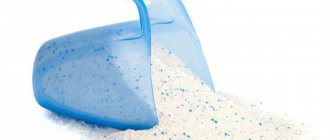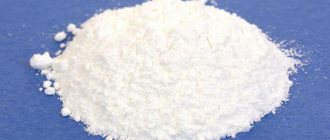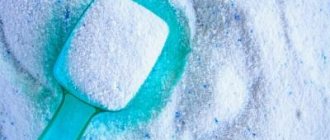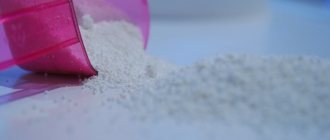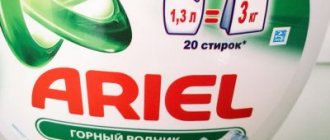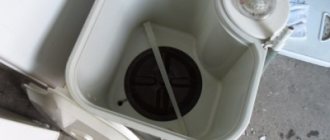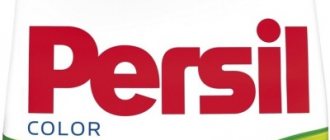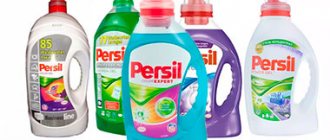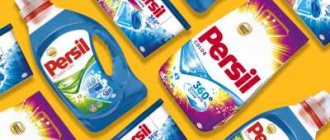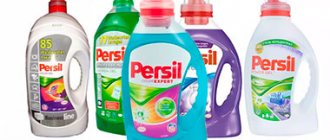Today, washing powder is taken for granted. Without it, a full process of washing things is impossible. However, just 150 years ago people had no idea what it was.
The article will discuss the history of the creation of washing powder, its benefits and harm to human health and the environment, and will list the leading manufacturers of laundry detergents and more.
Description of clothes washing detergent
Washing powder is a synthetic detergent related to household chemicals .
Powders have a complex, multicomponent composition, depending on which the specifics of their application differ.
All modern powdered products undergo granulation, which reduces the degree of dusting and also makes the process of use more convenient.
They are white in color, but in their composition you can often find multi-colored granules (green, red, blue, dark blue). The main purpose of powders is to remove dirt .
Types of washing powders by type of fabric and soiling
- Universal. Used by many housewives as basic household chemicals. They are much cheaper, cope with daily cleaning of things and are able to wash a variety of light stains.
- For white. The active formula of such compositions includes bleaches: chlorine, optical, oxygen-containing and others. They remove stubborn stains and give the surface a crystal white appearance.
- For people of color. They are distinguished by the presence of color-holding components. They prevent dyes from being washed out of the fibers and maintain brightness and color saturation. Even after repeated washings, things remain like new.
- With stain removers. Designed to remove specific stubborn stains. They have a powerful active formula. Moderately aggressive agents are placed directly into the cuvette. More powerful ones are used for washing.
- For delicate fabrics. The vast majority of washing powders are used for items made of cotton, synthetic and mixed fabrics. At the same time, for wool, silk, calico and other delicate fibers, you should use only compounds specially designed for this purpose.
History of creation
The first washing powder was created by German chemist Fritz Henkel. Its basis at that time was sodium silicate. In 1876, Fritz organized the Henkel company, which began releasing a new product called “bleaching soda” to the masses. It quickly became popular because it washed things well and was inexpensive.
The first soap powder appeared on the market a year later. Its creators founded the company Thompsons Seifenpulver GmbH. At the same time, the Henkel factory developed.
In June 1907, the first washing powder for cars (Persil) saw the light of day. This saved housewives from having to boil things to make them white.
In Russia, washing powder appeared only in 1953 , it was a product called “Novost”. It was produced in Kazan at a chemical plant. A new round of development occurred in 2000, as a result, a powder with a composition familiar to modern people entered the market.
What information should be indicated on quality products?
Be sure to pay attention to the following information:
- the packaging indicates that this product is a washing powder for children;
- the recommended age of children is indicated;
- composition in a language you understand;
- recommendations for washing different types of fabrics;
- consumption of funds for a certain volume of water and laundry;
- what kind of contaminants does this powder deal with?
- storage conditions;
- expiration dates should be clearly visible.
What's the harm?
The only benefit of powders is their ability to effectively remove various contaminants from things, making them clean. However, they are harmful to the human body and the environment.
For the human body
Surfactants that form the basis of washing powders are highly active compounds. When they enter the body, they accumulate in the cell membranes, covering them with a film and disrupting their functioning. If a lot of surfactants accumulate in the body, they disrupt metabolic processes and can even lead to cell destruction.
Anionic surfactants are especially dangerous . Their harmful effects on the body:
- impaired immunity;
- allergy provocation;
- brain damage;
- increased cholesterol levels in the blood, increased atherosclerosis;
- disruptions in the functioning of the nervous system;
- disturbances in the functioning of the liver, kidneys, and respiratory system.
Anti-active substances have the property of accumulating in internal organs. When they come into contact with unprotected skin, 0.6% of them settle in the liver, and 1.9% in the brain. They have a toxic effect on them.
Phosphates from washing powder only enhance the effect of anionic surfactants, promote their penetration through the skin and increased destruction of membranes. High toxic concentrations of surfactants remain on things for about 4 days.
Environmental impact
Drain water contains synthetic detergents. After processing, they end up in the sewer system and then in natural bodies of water. For the microorganisms living in them, the substances contained in the powders are poisons. They violate the organoleptic properties and biological parameters of water.
Moreover, wastewater containing dissolved powder has a pH level of 7-10, while for normal life of aquatic organisms it is 4.5-5.0. As a result, fish, reptiles and mammals suffer as the food chain is disrupted.
Due to surfactants and other harmful chemicals entering the water, water bodies begin to bloom, turning into swamps.
Rinse liquids
Fabric softeners are a product whose main task is to give fabrics softness and a fresh aroma. In addition, the following means:
- Reduces drying time for clothes;
- Additionally, they smooth out wrinkles on clothes, thereby speeding up and facilitating the ironing process;
- Prevents static electricity on clothing;
- Does not attract dirt particles.
Some products contain fragrances that can cause allergies, such as rashes.
When using air conditioners, you must follow the manufacturer's instructions. Thanks to the recommended amount per wash, it will be much easier to rinse the detergent from the fabric.
It is also worth remembering that conditioner should not be applied directly to the fabric, as this can damage the fibers.
Variety of shapes and types
The following types of washing powders are distinguished:
Universal compositions for different types of washing.- Machine washing machines.
- For hand wash.
- For delicate washing.
- Contains disinfectants.
- For white and colored laundry.
- For children's clothing.
- With air conditioning.
- For washing in hard or cold water, etc.
Different manufacturers produce different powders. They differ not only in composition, but also in smell. There are three forms of laundry detergents:
- ordinary bulk powders;
- gels represented by liquid concentrates;
- capsules - they contain a highly concentrated liquid gel.
It is most convenient to use capsules, since they do not need to be dosed, they do not generate dust and do not irritate the respiratory tract. However, they cost 2-3 times more than classic washing powder.
Types of washing powders by release form
Powdery
The classic version has a number of disadvantages. Household chemicals dissolve more slowly during washing and are less easy to rinse. If the product is of low quality, it generates dust and can cause allergies. But all automatic machines are designed specifically for it. And most importantly, such funds are much cheaper.
Gels
Liquid formulations have a more concentrated formulation. They instantly dissolve in water and are easy to rinse out. They act more actively in a cold washing solution, making them more gentle on fabric fibers. The gel product rinses out of the material very well. Even when washing down jackets and other outerwear, there are no streaks or white spots left on their surface.
Capsules
Universal tablets combine several drugs at once. Their compositions are selected to complement each other. Therefore, such products become more effective in solving complex washing problems. Its main drawback is its relatively high price.
Plates
Sheet detergents are the latest achievement of specialists in the field of household chemicals. They combine all the advantages of their predecessors: suitable for all types of fabrics, cope with complex stains, are safe, do not cause allergic reactions and are economical to use.
Features of choosing a washing composition
When choosing a washing powder, you need to consider its purpose. A prerequisite is to study the composition. You should not buy household chemicals that have expired.
Other points to pay attention to:
- Amount of surfactants. According to existing standards, their percentage should be less than 5%.
- All foreign-made media must have Russian-language information.
- The composition should not contain phosphates; responsible manufacturers replace them with safer zeolites.
- Purpose of the detergent. If the label says “for white clothes,” then it is not recommended to wash colored items with them.
- The composition of baby powder should be as natural as possible.
- The packaging must be tightly sealed, without any signs of tampering.
Read about how to choose washing powder here, for children's clothes - here. The rating of hypoallergenic laundry detergents is presented in this article, odorless powders in this article, and eco-powders in this one.
The difference between powder for hand washing and automatic washing is discussed here, the features of choosing soap powder are here, safe for a septic tank - in this article, the rating of detergents according to customer reviews is presented here.
“Automatic” or hand wash: what to choose?
It’s hard to even imagine how many women say “thank you” every day to the man who invented the automatic washing machine. All you have to do is load things into the drum and press the button, and that’s it! You can go paint your nails or knit a sweater for your husband. However, don’t delude yourself! After all, you need to select washing powder specifically for each type of laundry and type of washing. Don't think that this is just another ploy by laundry detergent companies. An incorrectly selected washing mode and detergent can damage the washing machine itself.
Powder for automatic machines.
This product is intended for processing (washing) laundry in an automatic machine.
When choosing a powder for an automatic machine, be sure to ensure that the packaging with the product contains the inscription “Automatic”. The desire not to spend extra money or neglect it will lead to machine breakdown. The powder in this category contains components that form much less foam than in hand washing products. These are foam absorbers (stabilizers) that prevent it from moving to a possibly acceptable level. Otherwise, foam penetrates into unsealed cracks and floods the mechanisms and all objects around. Washing powder in an automatic washing machine contains several more substances:
Kalgon. This is a special component that helps soften water and prevents scale from forming on the inner surface of the mechanisms. This substance does not contain aggressive chlorine or solvents. Therefore, it does not have a destructive effect on the rubber and plastic surfaces of the machine; Washing detergent for washing machines takes much longer to dissolve than the same powder for washing by hand; The concentration of active substances in machine washing products is very high; For each mode, it is advisable to select the optimal amount of detergent. As a rule, the dosage is indicated on the box. When the volume changes, the quality of the result obtained may decrease.
However, don't panic if you accidentally put hand washing powder in your washing machine. Nothing terrible will happen. Turn on the “Spin” mode, then “Rinse and Spin”. After completing the cleaning process, add the required amount of the substance and restart the desired washing mode.
Powder for hand washing.
Hand wash is a powder mixture for washing fabrics in regular washing machines or by hand.
These substances have a number of differences:
Contains ingredients that are gentle on the skin of your hands or soap. Baby soap is included in laundry detergents for babies; Despite the fact that the dissolution rate of granules of hand washing powders is quite high, you need to start washing only after they have completely disappeared; The higher the concentration of the solution (more product is poured into a certain amount of water), the more intensively the laundry needs to be rinsed. The optimal amount of powder for a certain volume of water is indicated on the packaging of the product.
It is impossible to achieve the desired effect from hand washing using an automatic powder.
Top producing countries
Powder production is carried out in many countries, but the leaders in this industry are the following countries:
Japan. Japanese washing powders do not contain phosphates, as they have been banned in the country for several years. They are sold in convenient modern packaging and equipped with a measuring spoon. The most popular brands: Attack, Lion, Miyoshi, Daiichi FUNS, Mitsuei Super Wash.- China. Chemicals produced in China are economical in consumption, have a minimal amount of flavorings, are highly effective and have a hypoallergenic composition. Popular brands: Liby, Keon, BioAqua, Laundry Detergent Sheets, Touching Nature.
- Korea. The formula of Korean washing powders does not contain phosphates, and the main active component is enzymes (enzymes) that are safe for human health and the environment. The most popular TMs: KeraSys Spark Drum, OATS, Lion Beat, Hanjang.
- Russia. Most formulations do not contain phosphates and are also affordable. The most popular brands: Ushasty Nyan, Umka, Sarma, Vorsinka, Stork, Sorti, Lotus.
- Belarus. Washing powders from Belarus wash well, do not contain phosphates and undergo strict control when entering the Russian market. Popular brands: Mara, April, Chaika, SanDay.
You can learn about German washing powders from this article.
How much powder should I pour?
The amount of detergent depends on several factors:
- Volume of loaded laundry.
- The degree of contamination of clothing - the higher it is, the more bulk substance is required.
- Hardness of water. If there is a residue on the walls of the dish after boiling, the water is hard.
- This can be compensated for with softeners.
- Selected type of washing (hand or machine).
- Selected mode.
Some newer models have a function that automatically determines the amount of powder needed for washing.
Typically, the manufacturer indicates the proportions of the detergent on the packaging, but in practice you can adhere to the following recommendations:
- 1 tbsp. l. (20-25 g) per 1 kg of laundry, if it is slightly soiled;
- 1.5-2 tbsp. l. in the presence of stubborn stains and increased water hardness.
Compound
The basis of all washing powders are anionic and nonionic surfactants. These surfactants weaken the bonds between contaminants and fabric fibers and prevent them from re-settling.
In addition to surfactants, the composition of laundry detergents is represented by the following components:
- Optical brighteners that create the illusion of snow-white laundry. This effect is achieved due to the deposition of luminescent particles on the fabric. When sunlight hits them, things appear white.
- Oxygen bleach.
- Soda and soap. They are designed to improve the quality of washing.
- Fragrances and flavors responsible for eliminating unpleasant odors and adding freshness to washed laundry.
- Phosphates. These components are necessary to soften water, which improves the quality of washing. Phosphates make laundry soft and protect washing machine elements from scale.
- Zeolites. They act as a safer alternative to phosphates.
- Sodium silicate, which alkalizes surfactants and also binds powder dust into granules.
- Enzymes (enzymes). They break down different types of contaminants through the manifestation of their biological activity.
- Defoamers. These substances prevent excessive foam formation.
Other components:
ballast substances,- solvents,
- chlorine,
- hydrotropes,
- anti-corrosion compounds,
- preservatives,
- antioxidants,
- additives that soften the skin of the hands,
- air conditioner, etc.
Read more about the composition of washing powder here, and about the GOST requirements here.
Additional properties of washing powders
Aggressive particles from traditional household chemicals negatively affect fibers. They make fabrics stiffer and rougher to the touch. Therefore, you have to use caring components separately or select formulations containing them. Here are the most common ones:
- Rinse aids. They restore the structure of the fibers, help wash out aggressive components from the surface, and give things softness and a pleasant aroma.
- Water softeners. Allow active components to dissolve faster and react with contaminants. Protects the heating elements of the automatic machine from scale deposits and subsequent breakdown.
- Antistatic agents. They make ironing easier and prevent small dust particles from quickly settling on fabrics. Thanks to this, clothes stay clean longer.
Having familiarized yourself with all the possibilities of household chemicals, you can accurately choose the appropriate washing powder that will quickly solve your problems.
If you find an error, please select a piece of text and press Ctrl+Enter.
Features of use
Recommendations for using washing powders:
- compliance with dosage and temperature conditions;
- use of powders according to their intended purpose (for white and colored laundry, for children, for people with hypersensitive skin);
- when washing in an automatic machine, the powder is poured into the first compartment only if the pre-wash or soaking program has been selected; in other cases, the detergent is poured into the second section;
- taking into account the concentration of chemicals - if the powder is concentrated, the dosage is reduced.
Woolen, half-woolen and cotton fabrics absorb surfactants the most, so they need to be rinsed especially carefully.
The rating of washing powders for colored items is presented in this article, for black - in this article, for white - here, for hand washing - here.
Is it possible to pour powder directly into the drum? This article will tell you where to put it correctly, in which compartment - this one, how much to pour - this one.
We wash it correctly: the sequence of actions when washing clothes
Every housewife knows that it is impossible to mix clothes of different colors when washing. Therefore, first all things need to be sorted. In addition, you should not wash outerwear with underwear or bed linen. Depending on the type of fabric, items are also laid out separately.
Before washing, bedding or clothes that are heavily soiled should be soaked in warm water for an hour. Synthetic fabrics do not require pre-soaking. For high-quality washing results, choose the appropriate method:
Ultrasonic washing machine. This small device can handle clothes that do not require aggressive washing. This applies to chiffon items, winter down jackets or quilts. This type of washing will preserve the shape and color of things for a long time; Color stabilizers. To preserve the color scheme of clothing or items, special stabilizers are produced. For example, there are substances that prevent black colors from fading. Including, there are powders whose packaging says “Color”. Products with this inscription are able to preserve the color of things for a long time. Black laundry detergents contain components that improve the rinsing properties of water. After washing and rinsing, no whitish stains remain on the fabrics; Manufacturers of household chemicals have developed special products for softening fabrics - bed linen or terry towels. At the same time, the fabric receives additional advantages - it wrinkles less, can be ironed perfectly, and even after that does not lose its softness. These products contain optical and chemical brighteners.
If your clothes are simply dusty, wash them with water. But only properly selected washing powder can deal with more complex stains.
Storage conditions
The composition can be stored both in the original packaging and in other suitable containers. The main thing is that the container is tightly closed . Do not allow moisture or debris to get inside.
The room chosen is dry, dark and cool. Children should not have access to detergent. It is important to monitor the expiration date of the composition and not use expired products. Read about expiration dates for washing powders here.
General concept
Washing powder is a product designed to remove stains from clothes, as well as to preserve the color characteristics of the fabric. Household products have different compositions that help cope with stains on any materials. Therefore, detergents are divided into classifications. Most often the composition of powders includes:
- Surface active elements;
- Binding components;
- Bleaching agents;
- Flavorings, enzymes.
Detergents on the household chemicals market are presented in the form of powder, gel and capsule products. Each of them is suitable for cleaning specific materials and varying degrees of contamination. High-quality products are gentle on the fabric and allow things to maintain their decent appearance for a long time.
Helpful information
Tips for choosing and using washing powder:
If you want to protect yourself as much as possible from exposure to harmful substances, you should give preference to soap-based powders.- You need to choose powders with a low pH level, which is close to the pH of the skin, which is 4.5.
However, you should be prepared for the fact that this level of acidity negatively affects the cleaning properties of the composition, so it will be worse to wash. - When washing by hand, you need to protect the skin of your hands from contact with the washing solution.
- Dust from laundry detergent can remain in the air for about 20 minutes. Therefore, it is strongly recommended not to place a washing machine in the kitchen.
How to replace washing powder if you run out of it, you can find out here, how to make it yourself - here.
Conclusion
So, the choice of powder is based on the answers to 3 simple questions:
- What type of laundry should be washed (bright, white, delicate)?
- Who will use the product and underwear after it (child, allergy sufferer)?
- How will the washing be done (by hand, in a machine, in several stages)?
Most often, of course, buyers choose universal powder as the most economical option. However, it is the correct selection of detergents that can ensure saving time and money, as well as health, comfort and preserved quality of all things that have survived repeated washing.
